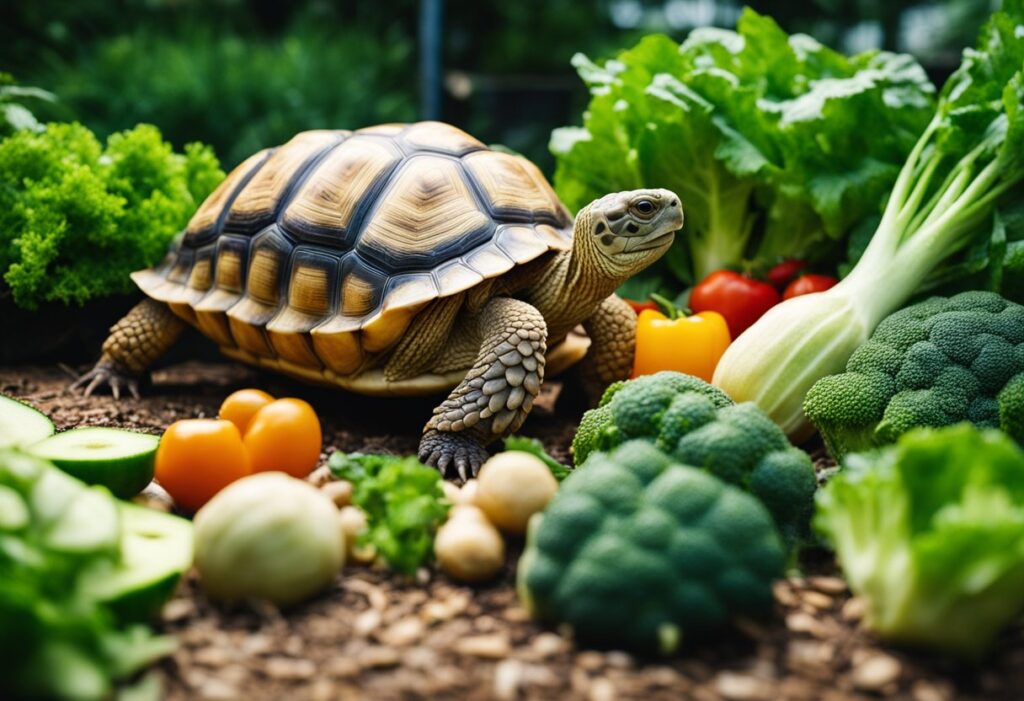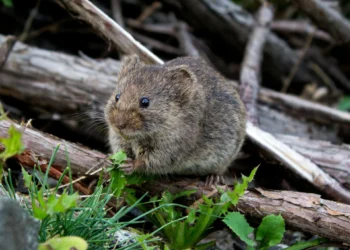Sulcata tortoises are herbivores and require a diet that is high in fiber and low in protein. As a result, it’s essential to know what vegetables are safe for them to eat. In this article, we will discuss the types of vegetables that are suitable for sulcata tortoises.
One of the most important things to consider when feeding sulcata tortoises vegetables is their nutritional value. Sulcata tortoises require a diet that is rich in fiber, vitamins, and minerals. While many vegetables are safe for them to eat, some may not provide the necessary nutrition.
It’s also important to note that not all vegetables are safe for sulcata tortoises to eat. Some vegetables can be harmful and even toxic to them. Therefore, it’s crucial to know which vegetables are safe and which ones to avoid. In the following paragraphs, we will provide a list of vegetables that are safe for sulcata tortoises to eat.
Understanding Sulcata Tortoises

Sulcata tortoises are one of the largest species of tortoises in the world, and they are native to the Sahara Desert in Africa. They are also known as African spurred tortoises or just spurred tortoises. These tortoises can grow up to 30 inches in length and weigh up to 200 pounds. They have a lifespan of up to 70 years in captivity.
Sulcata tortoises are herbivores, which means their diet consists of only plant matter. They have a high-fiber, low-protein diet, and they require a variety of vegetables to maintain a healthy diet. It is important to note that feeding them the wrong foods can lead to health problems such as obesity, metabolic bone disease, and shell deformities.
Sulcata tortoises are also known for their burrowing behavior. They dig deep burrows to escape the heat of the desert, and they can spend up to 95% of their time underground. They are also social animals and enjoy the company of other tortoises.
Overall, understanding the natural behavior and dietary needs of Sulcata tortoises is crucial for their well-being in captivity. Providing them with a proper diet and environment can ensure a long and healthy life.
Dietary Needs of Sulcata Tortoises
As owners of Sulcata Tortoises, it is important to understand their dietary needs to ensure their health and wellbeing. In the wild, Sulcata Tortoises are herbivores and consume a variety of grasses, weeds, and other vegetation. As pets, it is our responsibility to provide them with a similar diet to what they would consume in their natural habitat.
The primary component of a Sulcata Tortoise’s diet should be grasses and hay. Timothy hay is a good option and can be found at most pet stores. Fresh grasses such as Bermuda grass, fescue, and clover can also be provided. It is important to ensure that the grasses are free from pesticides and fertilizers.
In addition to grasses, Sulcata Tortoises can also consume a variety of vegetables. Some good options include dark leafy greens such as kale, collard greens, and mustard greens. Other vegetables such as carrots, squash, and sweet potatoes can also be provided in moderation. It is important to note that while vegetables can be a good addition to their diet, they should not make up the majority of their food intake.
Fruit should be given sparingly as it is high in sugar and can lead to health problems if given in excess. Some safe options include strawberries, raspberries, and melons. It is important to avoid feeding them citrus fruits as they can cause digestive problems.
It is also important to provide Sulcata Tortoises with a calcium supplement to ensure their shells stay healthy and strong. This can be done by providing a cuttlebone or a calcium supplement powder sprinkled on their food.
Overall, a balanced diet consisting of grasses, hay, and a variety of vegetables is essential for the health and wellbeing of Sulcata Tortoises. It is important to avoid feeding them foods that are high in protein or fat and to always ensure that their food is fresh and free from pesticides and fertilizers.
Leafy Green Vegetables

Leafy green vegetables are an essential part of a Sulcata Tortoise’s diet. They are a great source of vitamins and minerals, and they also provide the necessary fiber for good digestion. Here are some leafy green vegetables that we recommend for Sulcata Tortoises:
- Collard Greens: Collard greens are a great source of calcium and vitamin A. They are also high in fiber, which helps with digestion. We recommend feeding collard greens to your Sulcata Tortoise at least once a week.
- Mustard Greens: Mustard greens are another great source of calcium and vitamin A. They are also high in vitamin C, which helps boost the immune system. We recommend feeding mustard greens to your Sulcata Tortoise at least once a week.
- Turnip Greens: Turnip greens are high in calcium and vitamin A, and they are also a good source of vitamin K. Vitamin K helps with blood clotting and bone health. We recommend feeding turnip greens to your Sulcata Tortoise at least once a week.
- Kale: Kale is a superfood for Sulcata Tortoises. It is high in calcium, vitamin A, and vitamin C. It also contains antioxidants that help protect against disease. We recommend feeding kale to your Sulcata Tortoise once or twice a week.
- Dandelion Greens: Dandelion greens are a great source of calcium and vitamin A. They also help with digestion and can act as a natural diuretic. We recommend feeding dandelion greens to your Sulcata Tortoise at least once a week.
Remember to always wash your leafy green vegetables thoroughly before feeding them to your Sulcata Tortoise. Also, make sure to vary your tortoise’s diet and not feed the same vegetables every day.
Other Vegetables
In addition to the vegetables we mentioned earlier, there are several other vegetables that Sulcata tortoises can eat. Here are a few examples:
- Cabbage: Cabbage is a great source of vitamins and minerals, and Sulcata tortoises seem to enjoy it. However, it should be fed in moderation, as it contains a compound that can interfere with the absorption of iodine.
- Carrots: Carrots are a good source of vitamin A, which is important for maintaining healthy eyesight. They can be fed raw or cooked, but should be chopped into small pieces to avoid choking.
- Bell peppers: Bell peppers are a good source of vitamin C, which is important for maintaining a healthy immune system. They can be fed raw or cooked, but should be chopped into small pieces to avoid choking.
- Green beans: Green beans are a good source of fiber, which can help keep Sulcata tortoises regular. They can be fed raw or cooked, but should be chopped into small pieces to avoid choking.
- Pumpkin: Pumpkin is a good source of fiber and can help keep Sulcata tortoises regular. It can be fed raw or cooked, but should be chopped into small pieces to avoid choking.
Remember to always introduce new vegetables gradually and monitor your tortoise’s behavior and health. If you notice any adverse reactions, stop feeding that vegetable immediately.
Fruits
Sulcata tortoises can consume a variety of fruits, but they should only be given as occasional treats due to their high sugar content. Fruits should make up no more than 10% of their diet.
Some fruits that can be fed to Sulcata tortoises include:
- Apples
- Bananas
- Berries (strawberries, blueberries, raspberries, etc.)
- Mangoes
- Papayas
- Pineapples
- Watermelons
It is important to note that fruits with high acidity levels, such as citrus fruits, should be avoided as they can cause digestive issues. Additionally, fruits with seeds, like apples and watermelons, should have the seeds removed before feeding them to the tortoise.
When feeding fruits, it is recommended to cut them into small pieces to prevent choking hazards. As with all foods, fruits should be washed thoroughly before being given to the tortoise.
In conclusion, while fruits can be a tasty treat for Sulcata tortoises, they should only be given in moderation to avoid any potential health issues.
Foods to Avoid
As we mentioned earlier, Sulcata tortoises are herbivorous. However, not all vegetables are safe for them to consume. Here are some foods that you should avoid feeding your Sulcata tortoise:
- Fruits: Although Sulcata tortoises love fruits, they should be avoided as much as possible. Fruits are high in sugar, which can cause digestive problems and diarrhea in tortoises.
- Spinach and Swiss chard: These vegetables contain high levels of oxalic acid, which can bind with calcium in the tortoise’s body, leading to the formation of kidney stones.
- Cabbage and broccoli: These vegetables contain goitrogens, which can interfere with the thyroid gland’s function and cause goiter.
- Avocado: Avocado contains persin, a toxin that can cause respiratory distress, heart damage, and death in tortoises.
- Onions and garlic: These vegetables contain thiosulphate, which can cause anemia in tortoises.
It’s essential to keep in mind that feeding your Sulcata tortoise the wrong foods can lead to health problems and even death. Therefore, it’s crucial to research and understand the foods that are safe for your tortoise to consume.
Supplements and Vitamins

As we mentioned earlier, a Sulcata Tortoise’s diet should consist mainly of hay, grasses, and weeds. However, they may require additional supplements and vitamins to ensure they receive all the necessary nutrients.
One important supplement is calcium. Sulcata Tortoises require a lot of calcium to maintain healthy shells, bones, and muscles. Calcium can be provided in several ways, including calcium supplements, cuttlebone, and calcium-rich vegetables such as kale and collard greens.
Another important supplement is Vitamin D3. This vitamin helps the tortoise absorb calcium and maintain healthy bones. Vitamin D3 can be provided through exposure to natural sunlight or UVB lamps.
In addition to calcium and Vitamin D3, Sulcata Tortoises may require other vitamins and minerals. A good way to ensure they receive all the necessary nutrients is to provide a commercial tortoise diet or a vitamin and mineral supplement specifically designed for tortoises.
It’s important to note that supplements should never be a substitute for a healthy diet. A balanced diet consisting of hay, grasses, and weeds should always be the main focus of a Sulcata Tortoise’s diet.
Feeding Schedule
We recommend feeding your Sulcata tortoise a variety of vegetables on a daily basis. Adult Sulcata tortoises should be fed once a day, while juvenile tortoises should be fed twice a day.
When feeding your tortoise, it’s important to remember that they should be offered a variety of vegetables to ensure they receive a balanced diet. Offer a mix of leafy greens, vegetables, and fruits.
Here are some vegetables that are safe for Sulcata tortoises to eat:
- Collard greens
- Mustard greens
- Dandelion greens
- Kale
- Turnip greens
- Carrots
- Squash
- Bell peppers
- Cactus pads
- Green beans
It’s important to note that some vegetables, such as spinach, broccoli, and cauliflower, should only be fed in moderation due to their high oxalic acid content.
Additionally, we recommend avoiding feeding your tortoise fruits that are high in sugar, such as bananas and grapes. These should only be given as a rare treat.
Always provide fresh water for your tortoise and make sure to clean their feeding area regularly. By following a consistent feeding schedule and offering a variety of vegetables, your Sulcata tortoise will stay healthy and happy.
Conclusion
In conclusion, sulcata tortoises are herbivores and require a diet that is high in fiber and low in protein. It is important to provide them with a variety of vegetables to ensure they receive all the necessary nutrients.
Some vegetables that are safe for sulcata tortoises to eat include dark leafy greens, carrots, squash, bell peppers, and green beans. It is important to avoid vegetables that are high in oxalates, such as spinach and beet greens, as well as vegetables that are high in goitrogens, such as kale and broccoli.
Remember to always wash vegetables thoroughly before feeding them to your sulcata tortoise and to remove any uneaten food from their enclosure to prevent the growth of harmful bacteria.
By providing a balanced and varied diet, you can help ensure that your sulcata tortoise stays healthy and happy for years to come.
Frequently Asked Questions

What are some safe vegetables for a Sulcata tortoise’s diet?
Some safe vegetables for a Sulcata tortoise’s diet include collard greens, dandelion greens, endive, escarole, mustard greens, and turnip greens. These vegetables are high in fiber, calcium, and other essential nutrients.
What vegetables should be avoided when feeding a Sulcata tortoise?
Vegetables that should be avoided when feeding a Sulcata tortoise include spinach, broccoli, kale, and cabbage. These vegetables contain high levels of oxalates, which can bind to calcium and prevent its absorption.
What are some recommended foods for a baby Sulcata tortoise?
Some recommended foods for a baby Sulcata tortoise include grasses, hay, and leafy greens. It’s important to provide a varied diet to ensure they receive all the necessary nutrients for growth and development.
Can Sulcata tortoises eat honeydew or apples?
Sulcata tortoises can eat honeydew in moderation, but apples should be avoided. Apples have a high sugar content and can cause digestive issues for tortoises.
What flowers are safe for Sulcata tortoises to eat?
Some safe flowers for Sulcata tortoises to eat include hibiscus, nasturtium, and roses. It’s important to avoid flowers that have been treated with pesticides or other chemicals.
What is the best diet for a Sulcata tortoise?
The best diet for a Sulcata tortoise consists of a variety of grasses, hay, and leafy greens. It’s important to provide a balanced diet that includes a variety of vegetables to ensure they receive all the necessary nutrients for optimal health.











